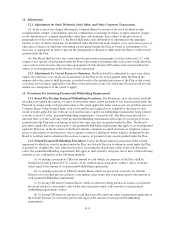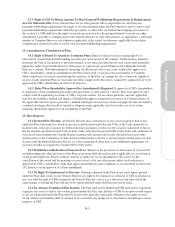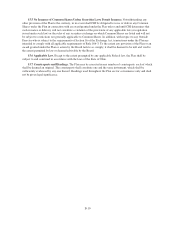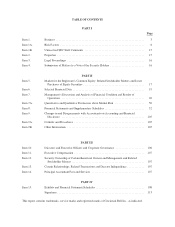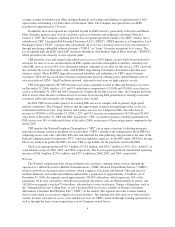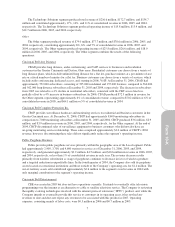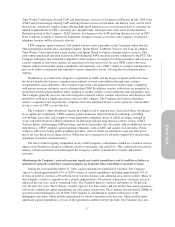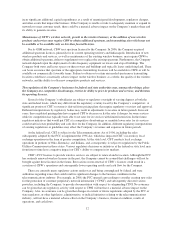Cincinnati Bell 2006 Annual Report Download - page 115
Download and view the complete annual report
Please find page 115 of the 2006 Cincinnati Bell annual report below. You can navigate through the pages in the report by either clicking on the pages listed below, or by using the keyword search tool below to find specific information within the annual report.
CBW began operations in 1998 as a joint venture with AT&T PCS LLC (“AWE”). The Company owned
80.1% of CBW, and AWE, which has been subsequently acquired by Cingular Wireless Corporation LLC
(“Cingular”), owned the remaining 19.9% of CBW. In response to Cingular’s acquisition of AWE, the Company
entered into an agreement (the “Agreement”) with Cingular on August 4, 2004 and subsequently amended it on
February 14, 2005, whereby the Company agreed to waive AWE’s prohibition against competing with CBW, and
Cingular agreed to forego certain minority rights including membership on CBW’s governing member
committee. In the Agreement, both parties agreed to new reciprocal roaming agreements, and put/call obligations
for the sale/purchase of the 19.9% of CBW owned by AWE. On February 14, 2006, the Company purchased
Cingular’s 19.9% membership interest in CBW for $83.2 million. As a result, the Company recognized minority
interest through the date of this purchase, but no CBW minority interest was recorded after this date since CBW
is now a wholly-owned subsidiary. The Company funded the purchase with borrowings from its bank credit
facility. Refer to Note 5 to the Consolidated Financial Statements.
CBW operates a digital wireless network, which is comprised of centralized switching and messaging
equipment connected to approximately 410 towers utilizing 30 MHz of wireless spectrum in each of the
Cincinnati and Dayton Basic Trading Areas (“BTA”). The Company owns the licenses to 30 MHz of spectrum in
Cincinnati and 20 MHz of spectrum in Dayton, and leases an additional 10 MHz license owned by Cingular in
the Dayton BTA. The lease for the Dayton spectrum, which was used for the Time Divisional Multiple Access
(“TDMA”) network, expires in April 2007. The Company does not expect to renew this spectrum, which it no
longer requires, as the Company no longer operates its TDMA network.
In the fourth quarter of 2006, the Company purchased an additional 20 MHz of advanced wireless spectrum
for the Cincinnati and Dayton, Ohio regions in the Advanced Wireless Services (“AWS”) spectrum auction
conducted by the FCC. To satisfy increasing demand for existing voice minutes of use by customers as well as to
provide enhanced data services such as streaming video, the Company intends to construct a third generation
(“3G”) network and deploy it on the newly purchased AWS spectrum. The Company expects to spend
approximately $30 million in 2007 to construct the 3G network so that it will be operational in 2008. In addition,
the Company also purchased advanced wireless spectrum outside of its traditional operating area, most notably
10 MHz for the Indianapolis, Indiana region. The Company is considering its options with respect to the
Indianapolis spectrum, which include expansion of its wireless operations into this area or lease of the spectrum
to another wireless provider. The Company spent $37.1 million on these spectrum purchases in 2006.
From October 2003 through June 2006, CBW operated two separate networks, TDMA and GSM. In the first
quarter of 2005, CBW upgraded GPRS to enhanced data rates for GSM evolution (“EDGE”), which provides up
to three times the capacity of GPRS. TDMA was CBW’s legacy technology, which it discontinued in June 2006.
In addition to the voice and short message data services that TDMA could provide, GPRS and EDGE technology
provide enhanced wireless data communication services, such as mobile web browsing, Internet access, email
and picture messaging.
The Wireless segment contributed $262.0 million, $237.5 million, and $261.7 million, or 21%, 20%, and
22% of consolidated revenue in 2006, 2005, and 2004, respectively. The Wireless segment produced operating
income of $20.2 million in 2006 and operating losses of $51.7 million and $1.4 million in 2005 and 2004,
respectively. Included in the 2005 operating loss are impairment charges related to the TDMA network assets
totaling $42.3 million and depreciation of the TDMA assets totaling $36.5 million. Included in the 2004
operating loss are impairment charges of $5.9 million to write-down certain TDMA assets and intangible assets
and $39.7 million related to depreciation of the TDMA assets.
Postpaid subscriber service generated approximately 71% of 2006 segment revenue. A variety of rate plans
are available to postpaid subscribers, and these plans typically include a fixed number of national minutes, an
unlimited number of mobile-to-mobile (calls to and from other CBW subscribers), an unlimited number of calls
to and from a CBT access line, or local minutes for a flat monthly rate. For plans with a fixed number of minutes,
postpaid subscribers can purchase additional minutes at a per-minute-of-use rate. Prepaid i-wirelessSM
subscribers, who accounted for 16% of 2006 revenue, can purchase minutes at a per-minute-of-use rate,
unlimited minutes for mobile-to-mobile or off-peak calls for a flat, per day fee, or unlimited usage for a flat
monthly fee. Revenue from other wireless service providers for the purchase of roaming minutes for the carrier’s
own subscribers using minutes on CBW’s network, collocation revenue (rent received for the placement of other
5





